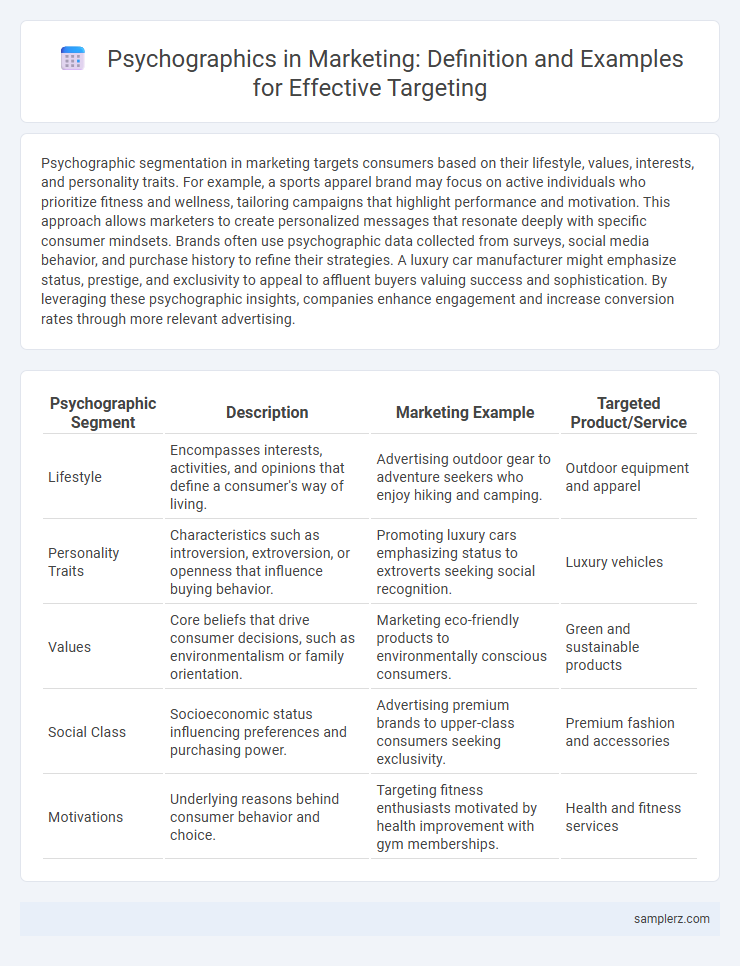Psychographic segmentation in marketing targets consumers based on their lifestyle, values, interests, and personality traits. For example, a sports apparel brand may focus on active individuals who prioritize fitness and wellness, tailoring campaigns that highlight performance and motivation. This approach allows marketers to create personalized messages that resonate deeply with specific consumer mindsets. Brands often use psychographic data collected from surveys, social media behavior, and purchase history to refine their strategies. A luxury car manufacturer might emphasize status, prestige, and exclusivity to appeal to affluent buyers valuing success and sophistication. By leveraging these psychographic insights, companies enhance engagement and increase conversion rates through more relevant advertising.
Table of Comparison
| Psychographic Segment | Description | Marketing Example | Targeted Product/Service |
|---|---|---|---|
| Lifestyle | Encompasses interests, activities, and opinions that define a consumer's way of living. | Advertising outdoor gear to adventure seekers who enjoy hiking and camping. | Outdoor equipment and apparel |
| Personality Traits | Characteristics such as introversion, extroversion, or openness that influence buying behavior. | Promoting luxury cars emphasizing status to extroverts seeking social recognition. | Luxury vehicles |
| Values | Core beliefs that drive consumer decisions, such as environmentalism or family orientation. | Marketing eco-friendly products to environmentally conscious consumers. | Green and sustainable products |
| Social Class | Socioeconomic status influencing preferences and purchasing power. | Advertising premium brands to upper-class consumers seeking exclusivity. | Premium fashion and accessories |
| Motivations | Underlying reasons behind consumer behavior and choice. | Targeting fitness enthusiasts motivated by health improvement with gym memberships. | Health and fitness services |
Understanding Psychographics in Marketing
Understanding psychographics in marketing involves analyzing consumer lifestyles, values, interests, and personality traits to tailor campaigns effectively. Brands targeting environmentally conscious consumers might emphasize sustainability and ethical practices in their messaging. This approach enhances customer engagement by aligning products with the audience's intrinsic motivations and emotional drivers.
Key Components of Psychographic Segmentation
Psychographic segmentation in marketing involves dividing consumers based on key components such as lifestyle, values, personality traits, and social class. For example, a fitness brand targets health-conscious individuals who prioritize wellness and active living, reflecting lifestyle and value-based segmentation. Understanding these components enables marketers to create tailored campaigns that resonate deeply with consumer motivations and preferences.
Psychographic Profiles: Real-World Examples
Psychographic profiles segment consumers based on lifestyle, values, attitudes, and interests, enabling marketers to tailor campaigns effectively. For instance, Nike targets athletically inclined individuals who value health, motivation, and achievement, leveraging these traits in product design and messaging. Similarly, Patagonia appeals to environmentally conscious consumers by emphasizing sustainability and adventure in their marketing strategies.
How Brands Use Lifestyle Segmentation
Brands utilize lifestyle segmentation by analyzing consumers' interests, activities, and opinions to tailor marketing strategies that resonate on a personal level. For example, fitness apparel companies target health-conscious individuals who prioritize active living, using messaging that highlights performance and wellness benefits. This psychographic approach enhances customer engagement by aligning brand values with the lifestyle choices of specific audience segments.
Consumer Values and Purchasing Behavior
Consumer values such as sustainability, social responsibility, and health consciousness significantly influence purchasing behavior in marketing. Brands that align their products with these core values often see increased customer loyalty and willingness to pay premium prices. Psychographic segmentation enables marketers to tailor messaging and product offerings to resonate deeply with these intrinsic motivations, driving more effective campaigns and higher conversion rates.
Motivations Driving Brand Loyalty
Motivations driving brand loyalty often stem from deep emotional connections, perceived self-expression, and the desire for social acceptance. Consumers motivated by status and identity frequently prefer brands that reflect their lifestyle and values, enhancing their sense of belonging. Understanding these psychographic factors enables marketers to tailor campaigns that resonate with customers' internal drives, fostering long-term loyalty.
Attitudes and Beliefs: Shaping Marketing Strategies
Attitudes and beliefs profoundly influence consumer behavior, guiding marketing strategies toward tailored messaging that resonates with target audiences. Brands leveraging psychographics analyze customers' values, opinions, and lifestyle preferences to create campaigns that foster emotional connections and brand loyalty. Understanding these psychological drivers enables marketers to design personalized experiences that align with consumers' core motivations and decision-making processes.
Psychographic Data: Collection and Application
Psychographic data, including values, attitudes, interests, and lifestyle preferences, enables marketers to segment audiences more effectively beyond basic demographics. Collecting this data through surveys, social media analysis, and behavioral tracking allows for highly personalized marketing campaigns tailored to consumer motivations and pain points. Applying psychographic insights enhances message relevance and boosts engagement, conversion rates, and customer loyalty by addressing the emotional and psychological drivers behind purchasing decisions.
Case Studies: Successful Psychographic Campaigns
Nike's "Dream Crazy" campaign effectively targeted consumers driven by ambition and resilience, utilizing inspirational storytelling to resonate with athletes and fitness enthusiasts seeking motivation. Dove's "Real Beauty" campaign focused on self-esteem and body positivity, appealing to women valuing authenticity and inclusivity, resulting in heightened brand loyalty and engagement. Apple's marketing strategy emphasizes innovation and creativity, attracting customers who prioritize cutting-edge technology and design, demonstrated by increased product demand and brand devotion.
Enhancing Targeting with Psychographic Insights
Psychographic insights in marketing involve analyzing consumer lifestyles, values, interests, and personality traits to enhance targeting precision. Brands leveraging psychographic data can create highly personalized campaigns that resonate emotionally with specific segments, increasing engagement and conversion rates. Using tools like surveys and social media analytics helps marketers understand motivations behind purchasing decisions, leading to more relevant messaging and product positioning.

example of psychographic in marketing Infographic
 samplerz.com
samplerz.com